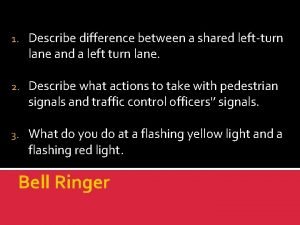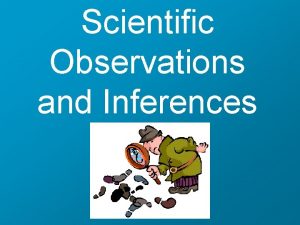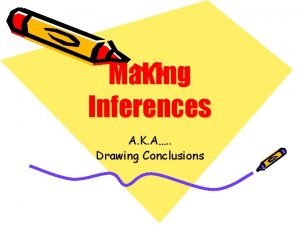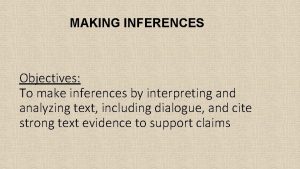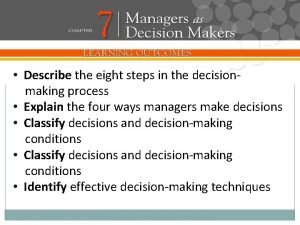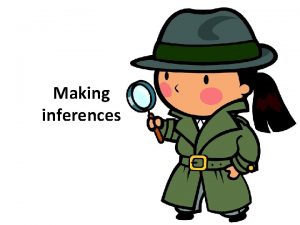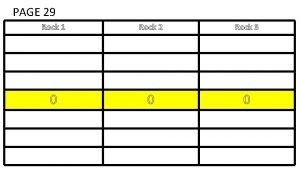Making Inferences Level Eight Mrs Hunsaker Rock Around




























- Slides: 28

Making Inferences Level Eight Mrs. Hunsaker

Rock Around The World April 12, 1954, is a famous date in the history of American music. On that day a radio station played, for the first time, a record called “Rock Around the Clock. ” For years the most popular American dance music had been played by big bands. , with a soft, easy beat. But this tune was different! It contained elements of the blues, and of country-and-western music. It had a hard, driving beat and was played on a small group of instruments – electric guitars, drums, and a jittery saxophone. The singer seemed to shout, rather than sing, the words. The sound wasn’t really new. What was new about it was its success. “Rock Around the Clock” was a national hit. Teenagers especially liked it, and began to listen to the records of other musicians who played in the same loud, exciting style. The music seemed to require a new style of dancing, too. Soon it had a name rock-and-roll, or simply rock. In one form or another, it had remained America’s most popular dance music.

“Rock Around the Clock” did not use a singer. a guitar. a piano.

Before April 12, 1954, rock-and-roll had never been played on the radio. there had never been a rock-and-roll hit. teen-agers seldom listened to the radio.

After April 12, 1954, people stopped listening to big-band music. all radio stations played rock-and-roll. many rock-and-roll records became popular.

Rock music at first was listened to only by teen-agers. developed out of older musical styles. was developed to be played to new dance steps.

Cable Cars San Francisco is known for many things its hills, its restaurants, the Golden Gate Bridge. But to many people, the real symbol of San Francisco is the cable car. These old wooden streetcars have no power of their own. They are driven by a cable that moves along continually under the street. The “driver” operates a lever that causes the car to grip the cable, and off it goes. To stop, the driver releases the car from the cable and applies a brake lever. When the car reaches the end of the line, it stops on a turntable. Passengers sometimes help the driver turn the car to face the other way. In earlier days, cable cars were the only way of getting over San Francisco’s steep hills. Now only two lines remain in operation. They’re operated mainly as at tourist attraction – but don’t tell this to the many San Francisco natives who use the cable cars to get to word.

Cable cars are driven by a cable in their engines. a cable moving under the street. gasoline.

Turning a cable car around is very dangerous. sometimes requires the passengers’ help. is done with levers.

Cable cars are still an important way of getting around San Francisco. found in most big cities. used only by tourists.

Cable cars were first built because the tourists liked them. they were a way of saving gas. it is difficult for horses to climb steep hills.

The Man Who Never Was The year was 1911, and the study of prehistoric man was an exciting new science. In England a man named Charles Dawson was claiming to have discovered the “missing link” between apes and human beings. In a gravel pit on Piltdown Common, he had noticed what looked like fossil bones. Dawson contacted A. Smith Woodward, a scientist, who came out to look at the fossils. He found a jawbone and fragments of a skull. The jaw was like that of an ape, while the skull was like that of a modern human being. Was “Piltdown Man” the missing link? Woodward announced that it was, and the discovery made him and Dawson famous. But other scientists were not to sure. For one thing, the jawbone was that of a young ape, but the back teeth were worn down like those of a human being – or a much older ape. Had someone filed the teeth down? Piltdown Man remained a mystery until the 1950’s, when more accurate methods of dating fossils proved that it was a fake. Had Dawson been responsible for the fake? Had Woodward? Both of them? By this time both men were long since dead.

The fossil was discovered by Charles Dawson. Charles Piltdown. A. Smith Woodward

The fossil was called Piltdown Man after the man who discovered it. place where it was discovered. man who discovered the fake.

For many years the fake went undetected because there was no accurate way to tell how old it was. Woodward would not let anybody see it. the skull was in pieces.

The jawbone was probably from a human being. an old ape. A young ape, but with the teeth filed down.

The Dinosaur That Wasn’t Dinosaur bones were discovered early in the 1800’s. No one knew what they were. People thought they were just big animals like the animals they knew. In 1841 an English scientist suggested that these bones weren’t like any living animals. He called the animals Dinosaurs. In 1877 in Colorado, scientists found a dinosaur skeleton. They named it Apatosaurus. Two years later in Wyoming, another dinosaur skeleton was found. The named the second skeleton Brontosaurus. Children loved to learn about Brontosaurus, the “Thunder Lizard. ” It was named for the sound that its big feet must have made. But in 1903, another scientist made a discovery. He proved that the skeletons of Brontosaurus and Apatosaurus were the same. There was one dinosaur not two! This was Apatosaurus. Brontosaurus was the dinosaur that wasn’t!

Brontosaurus and Apatosaurus looked alike. were very different. were cousins.

Apatosaurus probably was a swimmer. made a lot of noise walking. was always by himself.

Scientists before 1800 didn’t know about dinosaurs. knew about Brontosaurus. went on digs.

Scientists are always finding out more information about dinosaurs. sure of what they know. in agreement with each other.

Captain Kidd Was Captain William Kidd really a pirate? Is his treasure still buried Somewhere near New York? Captain Kidd was an honest trader and ship owner in 1696, when he was commissioned by the King of England as a privateer. This meant that he could legally attack enemy ships and pirates, and that he and his crew could keep half of whatever treasure they could seize. Soon after he sailed, some of his men were taken by the English navy for duty on its own ships. Kidd had to gather a new crew in New York, which was then a notorious haven for pirates. He then sailed to the Indian Ocean, looking for pirates and French ships. News soon came to England that Kidd had turned pirate himself, and was attacking ships of friendly countries. But was the news true? Some say that Kidd was falsely accused by his enemies in England. Others say that his crew had forced him to turn pirate When Kidd learned that he’d been accused of piracy, he sailed to Boston to try to clear his name. He was tricked into going ashore, arrested, taken to England, put on trial for piracy, and hanged. His treasure, which he had left with friends near New York, was seized by the government.

The story tells us that in 1696 Captain Kidd had already decided to turn pirate. England was at war with France. England was at war with the United States.

Many of the men who joined Kidd’s crew in New York had never sailed before. were probably pirates. were probably French.

Kidd probably learned that he had been accused of piracy when he was arrested. from sailors on another ship. by hearing the news on the ship’s radio.

The story suggests that what most people believe about Captain Kidd may not be true. Captain Kidd never was a pirate. Captain Kidd’s treasure is buried near New York.

You are ready to move to the next level!

 Types of igneous sedimentary and metamorphic rocks
Types of igneous sedimentary and metamorphic rocks Plane shape
Plane shape A short section of corrugated roadway that warns of hazards
A short section of corrugated roadway that warns of hazards Making inferences in science
Making inferences in science Making inferences and predictions
Making inferences and predictions Making inferences is reading between the lines
Making inferences is reading between the lines Inference objectives
Inference objectives Drawing conclusions and making inferences powerpoint
Drawing conclusions and making inferences powerpoint Drawing inferences and conclusions
Drawing inferences and conclusions Character inferences
Character inferences Making inferences: reading between the lines
Making inferences: reading between the lines Making inferences examples
Making inferences examples Is making inference simply making a guess
Is making inference simply making a guess Making inferences powerpoint
Making inferences powerpoint Inference objectives
Inference objectives Making inferences essential questions
Making inferences essential questions Making inferences with dialogue thank you ma'am
Making inferences with dialogue thank you ma'am Good inference questions
Good inference questions When drawing conclusions, make sure you
When drawing conclusions, make sure you Make inferences and draw conclusions
Make inferences and draw conclusions Brainpop making inferences
Brainpop making inferences They are mrs garcia and mrs castro
They are mrs garcia and mrs castro They are mrs garcia and mrs castro
They are mrs garcia and mrs castro Mrs. darling was ___________ of mrs. s.
Mrs. darling was ___________ of mrs. s. Eight steps of decision making
Eight steps of decision making What goes around comes around examples
What goes around comes around examples Goes around comes around meaning
Goes around comes around meaning Rock cycle
Rock cycle Igneous metamorphic and sedimentary
Igneous metamorphic and sedimentary


